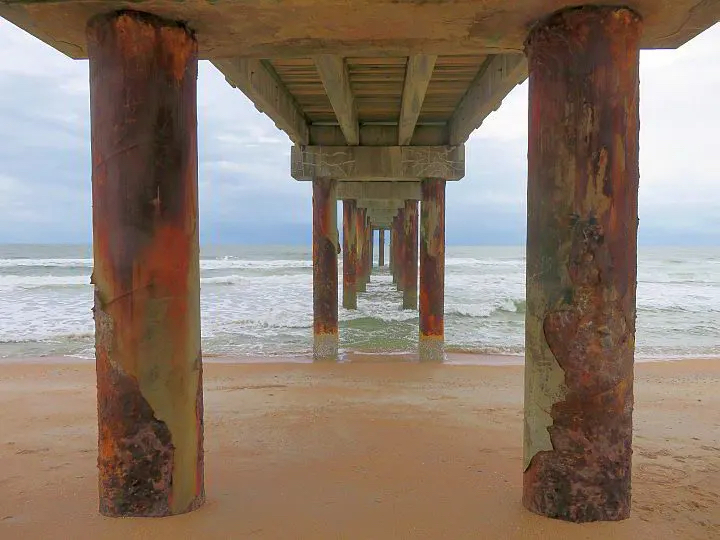
Beachcombing along the Southeastern Atlantic coast offers a balance of discovery, exercise, and restorative outdoor time. Whether strolling along sandy stretches at sunrise or winding through shell-rich tidal flats, the experience blends physical movement with the soothing rhythm of waves and the scent of salt air. For many, beachcombing offers a chance to combine light activity with exploration, bending and stretching while searching for nature’s keepsakes. The fresh ocean breeze provides a natural reset, while the quiet focus of scanning the sand encourages relaxation and calmness. Best of all, the treasures uncovered—whether seashells, sea glass, driftwood, or the occasional fossilized shark tooth—make each outing a rewarding adventure with its own sense of mystery.
It’s also worth remembering that not all finds are meant to be taken home; certain state parks and wildlife preserves regulate the collection of shells, corals, or other natural items to protect ecosystems. Visitors should always review posted guidelines or check beach regulations before removing any discoveries, ensuring a responsible and sustainable approach to beachcombing. For beachcombing enthusiasts who call the coast home or visit seasonally, the Southeastern Atlantic shores—from the barrier islands of the Carolinas to Georgia’s marsh-lined beaches and Florida’s golden coasts—offer some of the best opportunities to explore.
Hunting Island State Park – Beaufort, South Carolina

Hunting Island, just outside Beaufort, is South Carolina’s most popular state park and a remarkable spot for combing thanks to its shifting shoreline and undeveloped character. The beach is framed by maritime forest, salt marshes, and the iconic lighthouse, creating a wild yet inviting backdrop. Erosion regularly uncovers shells and driftwood, making every visit different. Beachcombers here often find sand dollars, scallop shells, and conchs washed ashore. Dogs are welcome, but they must remain on a leash, especially during nesting seasons when wildlife is active.
Folly Beach – Charleston, South Carolina

Just 20 minutes from downtown Charleston, Folly Beach boasts a lively community atmosphere, complemented by vast, sandy stretches perfect for beachcombing. Known locally as the “Edge of America,” Folly is a public beach with easy access and a reputation for fossilized shark teeth, particularly near the pier and at the quieter western end by Folly Beach County Park. The mix of shells and historic maritime relics makes it especially rewarding. Dogs are allowed year-round, but restricted to certain hours during the peak summer months.
Driftwood Beach – Jekyll Island, Georgia

Driftwood Beach, on Jekyll Island, is among the most visually striking coastal spots in the Southeast. Famous for its gnarled, weathered driftwood trees that litter the shoreline like sculptures, this public beach is both a photographer’s dream and a treasure trove for combers. Shell hunters can expect to find sand dollars, lettered olives, and moon snails. Its otherworldly landscape makes every walk feel like an exploration. Dogs are welcome and often accompany owners on long shoreline strolls. Beachcombing here is an experience like no other.
Cumberland Island National Seashore – St. Marys, Georgia

Accessible only by ferry from St. Marys, Cumberland Island National Seashore offers a remote and untouched setting for beachcombing. The island’s 17 miles of beach are backed by dunes, maritime forest, and even historic ruins. Collectors often stumble upon whelk shells, sand dollars, and shark teeth here, especially near the quieter northern end. Wild horses roam freely, adding to the island’s unique atmosphere. Because it’s a national seashore, visitors should check regulations on what can be collected. Pets are not allowed on the ferry or the island, so dogs cannot join the adventure here.
Tybee Island – Savannah, Georgia

Only 20 minutes from Savannah, Tybee Island combines accessibility with rewarding combing opportunities. North Beach, located near the lighthouse, is renowned for its abundance of cockle shells, while the southern end offers quieter stretches that are ideal for finding whelks and small conchs. As a public beach, Tybee has designated access points and plenty of walking space. Shark tooth hunters also frequent certain spots near the jetty. Dogs are not allowed on Tybee beaches; however, many pet-friendly accommodations are available nearby.
Little Talbot Island State Park – Jacksonville, Florida

Little Talbot Island, just north of Jacksonville, is one of Florida’s most undeveloped barrier islands. Its five miles of pristine shoreline are part of a state park that feels far removed from city life. The beach is especially rich in sand dollars, coquina shells, and driftwood, with tidal pools that invite close exploration. Visitors appreciate the natural quiet, where maritime hammock and dunes border the sands. Dogs are welcome in picnic and hiking areas, but not permitted on the beach itself. Beachcombing here is especially enjoyable, thanks to the serene environment.
Amelia Island – Fernandina Beach, Florida

Amelia Island, located near the Florida-Georgia border, is a beloved beachcombing destination with a distinctive character. Its public beaches stretch wide and offer easy access for long walks. Shark teeth, particularly black fossilized specimens, are common finds here along with whelk and clam shells. The island’s dunes and historic district nearby create a layered coastal experience that appeals to both nature lovers and history buffs. Beachcombing enthusiasts find much to explore here. Dogs are welcome on the beach, provided they remain leashed.
The Southeastern Atlantic coast presents a dynamic range of beachcombing opportunities, from the wild solitude of Cumberland Island to the family-friendly expanses of Folly and Tybee. Each destination offers its own blend of landscape, atmosphere, and treasures to uncover, creating experiences that remain memorable long after the day ends. With its mix of history, natural diversity, and shoreline access, this region ensures that every outing can feel like both an exploration and a reward. Whether one seeks rare shells, driftwood, or simply time spent in rhythm with the ocean, the beaches of the Southeast invite return visits and deeper connections.
Visitors should always check beachcombing regulations before taking home any finds to ensure they comply with local conservation laws and regulations. For more about living your best beach life, visit Beach Homes Lifestyles.

